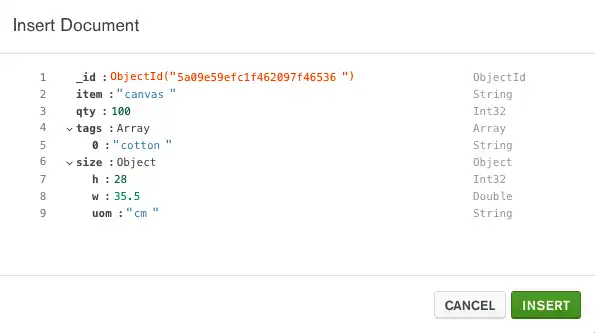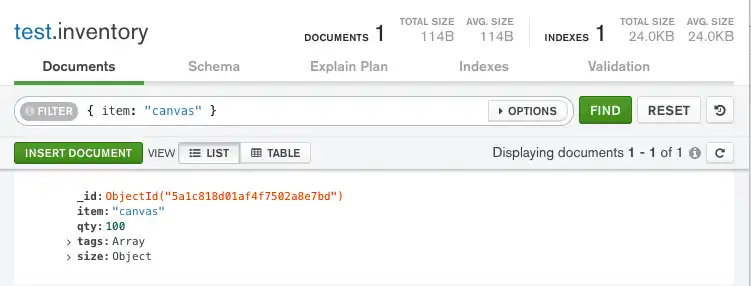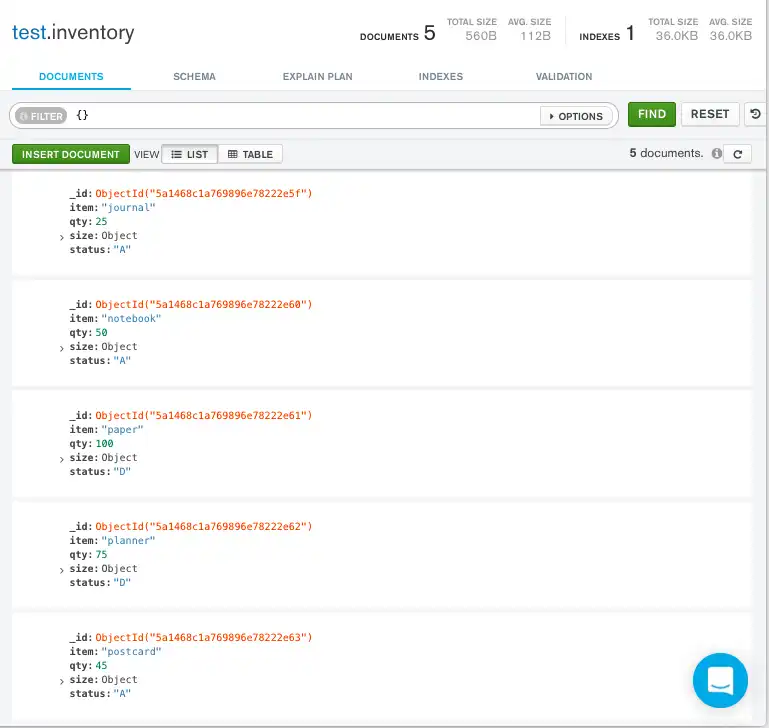插入文档
➤使用上角右侧的选择语言下拉菜单设置以下示例的语言或选择 MongoDB Compass。
本页提供了MongoDB中插入操作的示例。
您可以通过以下方法在MongoDB中插入文档:
您编程语言的驱动程序。
以下MongoDB Atlas UI。欲了解更多信息,请参阅MongoDB Atlas UI中的插入文档。
注意
创建集合
如果集合当前不存在,插入操作将创建集合。
在MongoDB Atlas UI中插入文档
要在MongoDB Atlas UI中插入一个文档,请完成以下步骤。有关在MongoDB Atlas UI中处理文档的更多信息,请参阅创建、查看、更新和删除文档。
在MongoDB Atlas UI中,转到集群页面,该页面属于您的项目。
如果它尚未显示,请从导航栏中的 组织菜单选择包含您所需项目的组织。
如果它尚未显示,请从导航栏中的项目菜单选择您的项目。
如果它尚未显示,请点击侧边栏中的集群。
集群页面显示集群。
插入单个文档
db.collection.insertOne() 将一个 单个 文档 插入到一个集合中。
以下示例将一个新文档插入到 inventory 集合中。如果文档没有指定 _id 字段,MongoDB 将添加一个包含 ObjectId 值的 _id 字段到新文档中。有关更多信息,请参阅 插入行为。
要使用 MongoDB Compass:
导航到您要插入文档的集合
在 MongoDB Compass 左侧导航面板中,点击您的目标集合所属的数据库。
从数据库视图,点击目标集合名称。
点击 插入文档 按钮
![Compass insert button]()
对于文档中的每个字段,选择字段类型并填写字段名称和值。通过单击最后一行数字,然后单击 在 ... 后添加字段 来添加字段。
对于
Object类型,通过单击最后一个字段的编号并选择 在 ... 后添加字段 来添加嵌套字段。对于
Array类型,通过单击最后一个元素的行编号并选择 在 ... 后添加数组元素 来向数组添加更多元素。
填写完所有字段后,单击 插入。
以下示例将新文档插入到 test.inventory 集合中
以下示例将新文档插入到 inventory 集合中。如果文档没有指定 _id 字段,C 驱动程序会向新文档中添加一个包含 ObjectId 值的 _id 字段。有关更多信息,请参阅 插入行为。
IMongoCollection.InsertOne() 将单个 文档 插入到集合中。
以下示例将新文档插入到 inventory 集合中。如果文档未指定 _id 字段,C# 驱动程序会自动添加一个包含 ObjectId 值的 _id 字段到新文档中。请参阅插入行为。
Collection.InsertOne 将单个 文档 插入到集合中。
以下示例将新文档插入到 inventory 集合中。如果文档未指定 _id 字段,驱动程序会自动添加一个包含 ObjectId 值的 _id 字段到新文档中。请参阅插入行为。
com.mongodb.reactivestreams.client.MongoCollection.insertOne 将一个 单个 文档 插入到使用 Java Reactive Streams Driver 的集合中
{ item: "canvas", qty: 100, tags: ["cotton"], size: { h: 28, w: 35.5, uom: "cm" } }
以下示例将上面的文档插入到 inventory 集合中。如果文档没有指定 _id 字段,驱动程序会向新文档添加一个包含 ObjectId 值的 _id 字段。请参阅 插入行为。
com.mongodb.client.MongoCollection.insertOne 将一个 单个 文档 插入到集合中。
以下示例将新文档插入到 inventory 集合中。如果文档未指定 _id 字段,驱动程序会自动添加一个包含 ObjectId 值的 _id 字段到新文档中。请参阅插入行为。
MongoCollection.insertOne 向集合中插入一个 单个 文档。
以下示例将新文档插入到 inventory 集合中。如果文档未指定 _id 字段,驱动程序会自动添加一个包含 ObjectId 值的 _id 字段到新文档中。请参阅插入行为。
motor.motor_asyncio.AsyncIOMotorCollection.insert_one 向集合中插入一个 单个 文档。
以下示例向 inventory 集合插入一个新文档。如果文档没有指定 _id 字段,Motor 驱动程序会向新文档添加具有 ObjectId 值的 _id 字段。请参阅插入行为。
Collection.insertOne() 向集合中插入一个 单个 文档。
以下示例将一个新的文档插入到 inventory 集合中。如果文档没有指定 _id 字段,Node.js 驱动程序会向新文档添加一个包含 ObjectId 值的 _id 字段。请参阅 插入行为。
MongoDB::Collection::insert_one() 插入一个 单个 文档 到集合中。
以下示例将一个新的文档插入到 inventory 集合中。如果文档没有指定 _id 字段,Perl 驱动程序会向新文档添加一个包含 ObjectId 值的 _id 字段。请参阅 插入行为。
MongoDB\\Collection::insertOne() 插入一个 单个 文档 到集合中。
以下示例将一个新的文档插入到 inventory 集合中。如果文档没有指定 _id 字段,PHP 驱动程序会向新文档添加一个包含 ObjectId 值的 _id 字段。请参阅 插入行为。
pymongo.collection.Collection.insert_one 插入一个 单个 文档 到集合中。
以下示例将一个新的文档插入到 inventory 集合中。如果文档没有指定 _id 字段,PyMongo 驱动程序会自动在新的文档中添加一个具有 ObjectId 值的 _id 字段。请参阅插入行为。
Mongo::Collection#insert_one() 将单个 文档 插入到集合中。
以下示例将一个新的文档插入到 inventory 集合中。如果文档没有指定 _id 字段,Ruby 驱动程序会在新的文档中添加一个具有 ObjectId 值的 _id 字段。请参阅插入行为。
collection.insertOne() 将单个 文档 插入到集合中。
以下示例将一个新的文档插入到 inventory 集合中。如果文档没有指定 _id 字段,Scala 驱动程序会在新的文档中添加一个具有 ObjectId 值的 _id 字段。请参阅插入行为。
db.inventory.insertOne( { item: "canvas", qty: 100, tags: ["cotton"], size: { h: 28, w: 35.5, uom: "cm" } } )

mongoc_collection_t *collection; bson_t *doc; bool r; bson_error_t error; collection = mongoc_database_get_collection (db, "inventory"); doc = BCON_NEW ( "item", BCON_UTF8 ("canvas"), "qty", BCON_INT64 (100), "tags", "[", BCON_UTF8 ("cotton"), "]", "size", "{", "h", BCON_DOUBLE (28), "w", BCON_DOUBLE (35.5), "uom", BCON_UTF8 ("cm"), "}"); r = mongoc_collection_insert_one (collection, doc, NULL, NULL, &error); bson_destroy (doc); if (!r) { MONGOC_ERROR ("%s\n", error.message); goto done; }
var document = new BsonDocument { { "item", "canvas" }, { "qty", 100 }, { "tags", new BsonArray { "cotton" } }, { "size", new BsonDocument { { "h", 28 }, { "w", 35.5 }, { "uom", "cm" } } } }; collection.InsertOne(document);
result, err := coll.InsertOne( context.TODO(), bson.D{ {"item", "canvas"}, {"qty", 100}, {"tags", bson.A{"cotton"}}, {"size", bson.D{ {"h", 28}, {"w", 35.5}, {"uom", "cm"}, }}, })
Document canvas = new Document("item", "canvas") .append("qty", 100) .append("tags", singletonList("cotton")); Document size = new Document("h", 28) .append("w", 35.5) .append("uom", "cm"); canvas.put("size", size); Publisher<Success> insertOnePublisher = collection.insertOne(canvas);
Document canvas = new Document("item", "canvas") .append("qty", 100) .append("tags", singletonList("cotton")); Document size = new Document("h", 28) .append("w", 35.5) .append("uom", "cm"); canvas.put("size", size); collection.insertOne(canvas);
result = collection.insertOne( Document("item", "canvas") .append("qty", 100) .append("tags", listOf("cotton")) .append("size", Document("h", 28) .append("w", 35.5) .append("uom", "cm") )
await db.inventory.insert_one( { "item": "canvas", "qty": 100, "tags": ["cotton"], "size": {"h": 28, "w": 35.5, "uom": "cm"}, } )
await db.collection('inventory').insertOne({ item: 'canvas', qty: 100, tags: ['cotton'], size: { h: 28, w: 35.5, uom: 'cm' } });
$db->coll("inventory")->insert_one( { item => "canvas", qty => 100, tags => ["cotton"], size => { h => 28, w => 35.5, uom => "cm" } } );
$insertOneResult = $db->inventory->insertOne([ 'item' => 'canvas', 'qty' => 100, 'tags' => ['cotton'], 'size' => ['h' => 28, 'w' => 35.5, 'uom' => 'cm'], ]);
db.inventory.insert_one( { "item": "canvas", "qty": 100, "tags": ["cotton"], "size": {"h": 28, "w": 35.5, "uom": "cm"}, } )
client[:inventory].insert_one({ item: 'canvas', qty: 100, tags: [ 'cotton' ], size: { h: 28, w: 35.5, uom: 'cm' } })
collection.insertOne( Document("item" -> "canvas", "qty" -> 100, "tags" -> Seq("cotton"), "size" -> Document("h" -> 28, "w" -> 35.5, "uom" -> "cm")) ).execute()
insertOne() 返回一个包含新插入文档的 _id 字段值的文档。有关返回文档的示例,请参阅db.collection.insertOne() 参考。
mongoc_collection_insert_one 函数在成功时返回 true,如果存在无效参数或服务器或网络错误,则返回 false 并设置错误。
Collection.InsertOne 函数返回一个 InsertOneResult 实例,其 InsertedID 属性包含新插入文档的 _id。
com.mongodb.reactivestreams.client.MongoCollection.insertOne 返回一个 Publisher 对象。当订阅者请求数据时,Publisher 将文档插入到集合中。
com.mongodb.client.MongoCollection.insertOne 返回一个 InsertOneResult 实例。您可以通过调用结果对象的 getInsertedId() 方法来访问插入文档的 _id 字段。
MongoCollection.insertOne 返回一个 InsertOneResult 实例。您可以通过访问结果的 insertedId 字段来访问插入文档的 _id 字段。
insert_one 返回一个 pymongo.results.InsertOneResult 实例,其中 inserted_id 字段包含新插入文档的 _id。
insertOne() 返回一个提供 result 的 promise。该 result.insertedId promise 包含新插入文档的 _id。
在成功插入后,insert_one() 方法返回一个 MongoDB::InsertOneResult 实例,其中 inserted_id 属性包含新插入文档的 _id。
在成功插入后,insertOne() 方法返回一个 MongoDB\\InsertOneResult 实例,其 getInsertedId() 方法返回新插入文档的 _id。
insert_one 返回一个 pymongo.results.InsertOneResult 的实例,其中 inserted_id 字段包含新插入文档的 _id。
在成功插入后,insert_one() 方法返回一个 Mongo::Operation::Result 的实例,其中 inserted_id 属性包含新插入文档的 _id。
在成功插入后,collection.insertOne() 方法返回一个包含新插入文档的 _id 的 collection.insertOne().results(); 实例。
要检索您刚刚插入的文档,请查询集合:
db.inventory.find( { item: "canvas" } )

在 MongoDB Compass 查询栏中指定一个过滤器,然后点击 查找 来执行查询。
上述过滤器指定 MongoDB Compass 只返回字段 item 等于 canvas 的文档。
有关 MongoDB Compass 查询栏的更多信息,请参阅 Compass 的 查询栏 文档。
mongoc_collection_t *collection; bson_t *filter; mongoc_cursor_t *cursor; collection = mongoc_database_get_collection (db, "inventory"); filter = BCON_NEW ("item", BCON_UTF8 ("canvas")); cursor = mongoc_collection_find_with_opts (collection, filter, NULL, NULL);
var filter = Builders<BsonDocument>.Filter.Eq("item", "canvas"); var result = collection.Find(filter).ToList();
cursor, err := coll.Find( context.TODO(), bson.D{{"item", "canvas"}}, )
FindPublisher<Document> findPublisher = collection.find(eq("item", "canvas"));
FindIterable<Document> findIterable = collection.find(eq("item", "canvas"));
val flowInsertOne = collection .find(eq("item", "canvas")) .firstOrNull()
cursor = db.inventory.find({"item": "canvas"})
const cursor = db.collection('inventory').find({ item: 'canvas' });
$cursor = $db->coll("inventory")->find( { item => "canvas" } );
$cursor = $db->inventory->find(['item' => 'canvas']);
cursor = db.inventory.find({"item": "canvas"})
client[:inventory].find(item: 'canvas')
val observable = collection.find(equal("item", "canvas"))
插入多个文档
db.collection.insertMany() 可以将多个 文档 插入到集合中。将文档数组传递给此方法。
以下示例将三个新文档插入到 inventory 集合中。如果文档没有指定 _id 字段,MongoDB 会为每个文档添加一个具有 ObjectId 值的 _id 字段。请参阅 插入行为。
mongoc_bulk_operation_insert_with_opts 可以将多个 文档 插入到集合中。您必须将文档的可迭代对象传递给此方法。
以下示例将三个新文档插入到 inventory 集合中。如果文档没有指定 _id 字段,C 驱动程序会为每个文档添加一个具有 ObjectId 值的 _id 字段。请参阅 插入行为。
IMongoCollection.InsertMany() 可以将多个 文档 插入到集合中。将文档的可枚举集合传递给此方法。
以下示例将三个新文档插入到 inventory 集合中。如果文档没有指定 _id 字段,驱动程序会为每个文档添加一个具有 ObjectId 值的 _id 字段。请参阅 插入行为。
Collection.InsertMany 可以向集合中插入 多个 文档。
以下示例将三个新文档插入到 inventory 集合中。如果文档没有指定 _id 字段,驱动程序会为每个文档添加一个具有 ObjectId 值的 _id 字段。请参阅 插入行为。
com.mongodb.reactivestreams.client.MongoCollection.html.insertMany 使用 Java Reactive Streams Driver 插入以下文档
{ item: "journal", qty: 25, tags: ["blank", "red"], size: { h: 14, w: 21, uom: "cm" } } { item: "mat", qty: 85, tags: ["gray"], size: { h: 27.9, w: 35.5, uom: "cm" } } { item: "mousepad", qty: 25, tags: ["gel", "blue"], size: { h: 19, w: 22.85, uom: "cm" } }
以下示例将三个新文档插入到 inventory 集合中。如果文档没有指定 _id 字段,驱动程序会为每个文档添加一个具有 ObjectId 值的 _id 字段。请参阅 插入行为。
com.mongodb.client.MongoCollection.insertMany 可以向集合中插入 多个 文档。将文档列表传递给此方法。
以下示例将三个新文档插入到 inventory 集合中。如果文档没有指定 _id 字段,驱动程序会为每个文档添加一个具有 ObjectId 值的 _id 字段。请参阅 插入行为。
MongoCollection.insertMany 向集合中插入 多个 文档。将文档列表作为参数传递给该方法。
以下示例向 inventory 集合中插入三个新文档。如果文档没有指定 _id 字段,驱动程序将为每个文档添加一个 ObjectId 值。参见 插入行为。
motor.motor_asyncio.AsyncIOMotorCollection.insert_many 可以向集合中插入 多个 文档。将文档的可迭代对象传递给此方法。
以下示例向 inventory 集合插入三个新文档。如果文档未指定 _id 字段,PyMongo 驱动程序将为每个文档添加一个包含 ObjectId 值的 _id 字段。请参阅 插入行为。
Collection.insertMany() 可以向集合中插入 多个 文档。将文档数组传递给此方法。
以下示例向 inventory 集合插入三个新文档。如果文档未指定 _id 字段,Node.js 驱动程序将为每个文档添加一个包含 ObjectId 值的 _id 字段。请参阅 插入行为。
MongoDB::Collection::insert_many() 可以将多个文档插入到集合中。将文档的数组引用传递给该方法。
以下示例将三个新文档插入到 inventory 集合中。如果文档没有指定 _id 字段,Perl 驱动程序将为每个文档添加带有 ObjectId 值的 _id 字段。请参阅 插入行为。
MongoDB\\Collection::insertMany() 可以将多个文档插入到集合中。将文档数组传递给该方法。
以下示例将三个新文档插入到 inventory 集合中。如果文档没有指定 _id 字段,PHP 驱动程序将为每个文档添加带有 ObjectId 值的 _id 字段。请参阅 插入行为。
pymongo.collection.Collection.insert_many 可以将多个文档插入到集合中。将文档的可迭代对象传递给该方法。
以下示例向 inventory 集合插入三个新文档。如果文档未指定 _id 字段,PyMongo 驱动程序将为每个文档添加一个包含 ObjectId 值的 _id 字段。请参阅 插入行为。
Mongo::Collection#insert_many() 可以将多个文档插入到集合中。将文档数组传递给此方法。
以下示例将三个新文档插入到 inventory 集合中。如果文档没有指定 _id 字段,Ruby 驱动程序将为每个文档添加包含 ObjectId 值的 _id 字段。参见 插入行为。
collection.insertMany() 可以将多个文档插入到集合中。
以下示例将三个新文档插入到 inventory 集合中。如果文档没有指定 _id 字段,Scala 驱动程序将为每个文档添加包含 ObjectId 值的 _id 字段。参见 插入行为。
db.inventory.insertMany([ { item: "journal", qty: 25, tags: ["blank", "red"], size: { h: 14, w: 21, uom: "cm" } }, { item: "mat", qty: 85, tags: ["gray"], size: { h: 27.9, w: 35.5, uom: "cm" } }, { item: "mousepad", qty: 25, tags: ["gel", "blue"], size: { h: 19, w: 22.85, uom: "cm" } } ])
[ { "item": "canvas", "qty": 100, "size": { "h": 28, "w": 35.5, "uom": "cm" }, "status": "A" }, { "item": "journal", "qty": 25, "size": { "h": 14, "w": 21, "uom": "cm" }, "status": "A" }, { "item": "mat", "qty": 85, "size": { "h": 27.9, "w": 35.5, "uom": "cm" }, "status": "A" }, { "item": "mousepad", "qty": 25, "size": { "h": 19, "w": 22.85, "uom": "cm" }, "status": "P" }, { "item": "notebook", "qty": 50, "size": { "h": 8.5, "w": 11, "uom": "in" }, "status": "P" }, { "item": "paper", "qty": 100, "size": { "h": 8.5, "w": 11, "uom": "in" }, "status": "D" }, { "item": "planner", "qty": 75, "size": { "h": 22.85, "w": 30, "uom": "cm" }, "status": "D" }, { "item": "postcard", "qty": 45, "size": { "h": 10, "w": 15.25, "uom": "cm" }, "status": "A" }, { "item": "sketchbook", "qty": 80, "size": { "h": 14, "w": 21, "uom": "cm" }, "status": "A" }, { "item": "sketch pad", "qty": 95, "size": { "h": 22.85, "w": 30.5, "uom": "cm" }, "status": "A" } ]
有关使用MongoDB Compass插入文档的说明,请参阅 插入文档。
mongoc_collection_t *collection; mongoc_bulk_operation_t *bulk; bson_t *doc; bool r; bson_error_t error; bson_t reply; collection = mongoc_database_get_collection (db, "inventory"); bulk = mongoc_collection_create_bulk_operation_with_opts (collection, NULL); doc = BCON_NEW ( "item", BCON_UTF8 ("journal"), "qty", BCON_INT64 (25), "tags", "[", BCON_UTF8 ("blank"), BCON_UTF8 ("red"), "]", "size", "{", "h", BCON_DOUBLE (14), "w", BCON_DOUBLE (21), "uom", BCON_UTF8 ("cm"), "}"); r = mongoc_bulk_operation_insert_with_opts (bulk, doc, NULL, &error); bson_destroy (doc); if (!r) { MONGOC_ERROR ("%s\n", error.message); goto done; } doc = BCON_NEW ( "item", BCON_UTF8 ("mat"), "qty", BCON_INT64 (85), "tags", "[", BCON_UTF8 ("gray"), "]", "size", "{", "h", BCON_DOUBLE (27.9), "w", BCON_DOUBLE (35.5), "uom", BCON_UTF8 ("cm"), "}"); r = mongoc_bulk_operation_insert_with_opts (bulk, doc, NULL, &error); bson_destroy (doc); if (!r) { MONGOC_ERROR ("%s\n", error.message); goto done; } doc = BCON_NEW ( "item", BCON_UTF8 ("mousepad"), "qty", BCON_INT64 (25), "tags", "[", BCON_UTF8 ("gel"), BCON_UTF8 ("blue"), "]", "size", "{", "h", BCON_DOUBLE (19), "w", BCON_DOUBLE (22.85), "uom", BCON_UTF8 ("cm"), "}"); r = mongoc_bulk_operation_insert_with_opts (bulk, doc, NULL, &error); bson_destroy (doc); if (!r) { MONGOC_ERROR ("%s\n", error.message); goto done; } /* "reply" is initialized on success or error */ r = (bool) mongoc_bulk_operation_execute (bulk, &reply, &error); if (!r) { MONGOC_ERROR ("%s\n", error.message); }
var documents = new BsonDocument[] { new BsonDocument { { "item", "journal" }, { "qty", 25 }, { "tags", new BsonArray { "blank", "red" } }, { "size", new BsonDocument { { "h", 14 }, { "w", 21 }, { "uom", "cm"} } } }, new BsonDocument { { "item", "mat" }, { "qty", 85 }, { "tags", new BsonArray { "gray" } }, { "size", new BsonDocument { { "h", 27.9 }, { "w", 35.5 }, { "uom", "cm"} } } }, new BsonDocument { { "item", "mousepad" }, { "qty", 25 }, { "tags", new BsonArray { "gel", "blue" } }, { "size", new BsonDocument { { "h", 19 }, { "w", 22.85 }, { "uom", "cm"} } } }, }; collection.InsertMany(documents);
result, err := coll.InsertMany( context.TODO(), []interface{}{ bson.D{ {"item", "journal"}, {"qty", int32(25)}, {"tags", bson.A{"blank", "red"}}, {"size", bson.D{ {"h", 14}, {"w", 21}, {"uom", "cm"}, }}, }, bson.D{ {"item", "mat"}, {"qty", int32(25)}, {"tags", bson.A{"gray"}}, {"size", bson.D{ {"h", 27.9}, {"w", 35.5}, {"uom", "cm"}, }}, }, bson.D{ {"item", "mousepad"}, {"qty", 25}, {"tags", bson.A{"gel", "blue"}}, {"size", bson.D{ {"h", 19}, {"w", 22.85}, {"uom", "cm"}, }}, }, })
Document journal = new Document("item", "journal") .append("qty", 25) .append("tags", asList("blank", "red")); Document journalSize = new Document("h", 14) .append("w", 21) .append("uom", "cm"); journal.put("size", journalSize); Document mat = new Document("item", "mat") .append("qty", 85) .append("tags", singletonList("gray")); Document matSize = new Document("h", 27.9) .append("w", 35.5) .append("uom", "cm"); mat.put("size", matSize); Document mousePad = new Document("item", "mousePad") .append("qty", 25) .append("tags", asList("gel", "blue")); Document mousePadSize = new Document("h", 19) .append("w", 22.85) .append("uom", "cm"); mousePad.put("size", mousePadSize); Publisher<Success> insertManyPublisher = collection.insertMany(asList(journal, mat, mousePad));
Document journal = new Document("item", "journal") .append("qty", 25) .append("tags", asList("blank", "red")); Document journalSize = new Document("h", 14) .append("w", 21) .append("uom", "cm"); journal.put("size", journalSize); Document mat = new Document("item", "mat") .append("qty", 85) .append("tags", singletonList("gray")); Document matSize = new Document("h", 27.9) .append("w", 35.5) .append("uom", "cm"); mat.put("size", matSize); Document mousePad = new Document("item", "mousePad") .append("qty", 25) .append("tags", asList("gel", "blue")); Document mousePadSize = new Document("h", 19) .append("w", 22.85) .append("uom", "cm"); mousePad.put("size", mousePadSize); collection.insertMany(asList(journal, mat, mousePad));
results = collection.insertMany( listOf( Document("item", "journal") .append("qty", 25) .append("tags", listOf("blank", "red")) .append("size", Document("h", 14) .append("w", 21) .append("uom", "cm") ), Document("item", "mat") .append("qty", 25) .append("tags", listOf("gray")) .append("size", Document("h", 27.9) .append("w", 35.5) .append("uom", "cm") ), Document("item", "mousepad") .append("qty", 25) .append("tags", listOf("gel", "blue")) .append("size", Document("h", 19) .append("w", 22.85) .append("uom", "cm") ) )
await db.inventory.insert_many( [ { "item": "journal", "qty": 25, "tags": ["blank", "red"], "size": {"h": 14, "w": 21, "uom": "cm"}, }, { "item": "mat", "qty": 85, "tags": ["gray"], "size": {"h": 27.9, "w": 35.5, "uom": "cm"}, }, { "item": "mousepad", "qty": 25, "tags": ["gel", "blue"], "size": {"h": 19, "w": 22.85, "uom": "cm"}, }, ] )
await db.collection('inventory').insertMany([ { item: 'journal', qty: 25, tags: ['blank', 'red'], size: { h: 14, w: 21, uom: 'cm' } }, { item: 'mat', qty: 85, tags: ['gray'], size: { h: 27.9, w: 35.5, uom: 'cm' } }, { item: 'mousepad', qty: 25, tags: ['gel', 'blue'], size: { h: 19, w: 22.85, uom: 'cm' } } ]);
$db->coll("inventory")->insert_many( [ { item => "journal", qty => 25, tags => [ "blank", "red" ], size => { h => 14, w => 21, uom => "cm" } }, { item => "mat", qty => 85, tags => ["gray"], size => { h => 27.9, w => 35.5, uom => "cm" } }, { item => "mousepad", qty => 25, tags => [ "gel", "blue" ], size => { h => 19, w => 22.85, uom => "cm" } } ] );
$insertManyResult = $db->inventory->insertMany([ [ 'item' => 'journal', 'qty' => 25, 'tags' => ['blank', 'red'], 'size' => ['h' => 14, 'w' => 21, 'uom' => 'cm'], ], [ 'item' => 'mat', 'qty' => 85, 'tags' => ['gray'], 'size' => ['h' => 27.9, 'w' => 35.5, 'uom' => 'cm'], ], [ 'item' => 'mousepad', 'qty' => 25, 'tags' => ['gel', 'blue'], 'size' => ['h' => 19, 'w' => 22.85, 'uom' => 'cm'], ], ]);
db.inventory.insert_many( [ { "item": "journal", "qty": 25, "tags": ["blank", "red"], "size": {"h": 14, "w": 21, "uom": "cm"}, }, { "item": "mat", "qty": 85, "tags": ["gray"], "size": {"h": 27.9, "w": 35.5, "uom": "cm"}, }, { "item": "mousepad", "qty": 25, "tags": ["gel", "blue"], "size": {"h": 19, "w": 22.85, "uom": "cm"}, }, ] )
client[:inventory].insert_many([{ item: 'journal', qty: 25, tags: ['blank', 'red'], size: { h: 14, w: 21, uom: 'cm' } }, { item: 'mat', qty: 85, tags: ['gray'], size: { h: 27.9, w: 35.5, uom: 'cm' } }, { item: 'mousepad', qty: 25, tags: ['gel', 'blue'], size: { h: 19, w: 22.85, uom: 'cm' } } ])
collection.insertMany(Seq( Document("item" -> "journal", "qty" -> 25, "tags" -> Seq("blank", "red"), "size" -> Document("h" -> 14, "w" -> 21, "uom" -> "cm")), Document("item" -> "mat", "qty" -> 85, "tags" -> Seq("gray"), "size" -> Document("h" -> 27.9, "w" -> 35.5, "uom" -> "cm")), Document("item" -> "mousepad", "qty" -> 25, "tags" -> Seq("gel", "blue"), "size" -> Document("h" -> 19, "w" -> 22.85, "uom" -> "cm")) )).execute()
insertMany() 返回一个包含新插入文档 _id 字段值的文档。参见 参考 以获取示例。
要检索插入的文档,请 查询集合:
mongoc_bulk_operation_insert_with_opts 函数在成功时返回 true,如果传入无效参数则返回 false。
要检索插入的文档,请使用 mongoc_collection_find_with_opts 查询集合:查询文档:
要检索插入的文档,请 查询集合:
要检索插入的文档,请 查询集合:
com.mongodb.reactivestreams.client.MongoCollection.html.insertMany 返回一个 Publisher 对象。当订阅者请求数据时,Publisher 将文档插入到集合中。
要检索插入的文档,请 查询集合:
要检索插入的文档,请 查询集合:
MongoCollection.insertMany() 返回一个 InsertManyResult 实例。在 InsertManyResult 的 insertedIds 字段中包含插入文档的 _id 值。
要检索插入的文档,请 查询集合:
insert_many 返回一个实例,该实例的 inserted_ids 字段是一个包含每个新插入文档的 _id 的列表。
要检索插入的文档,请 查询集合:
insertMany() 返回一个 promise,该 promise 提供一个 result。其中,result.insertedIds 字段包含一个数组,该数组包含每个新插入文档的 _id。
要检索插入的文档,请 查询集合:
在成功插入后,insert_many() 方法返回一个 MongoDB::InsertManyResult 实例,该实例的 inserted_ids 属性是一个包含每个新插入文档的 _id 的列表。
要检索插入的文档,请 查询集合:
在成功插入后,insertMany() 方法返回一个 MongoDB\\InsertManyResult 实例,该实例的 getInsertedIds() 方法返回每个新插入文档的 _id。
要检索插入的文档,请 查询集合:
insert_many 返回一个 pymongo.results.InsertManyResult 实例,其中 inserted_ids 字段是一个包含每个新插入文档的 _id 的列表。
要检索插入的文档,请 查询集合:
在成功插入后,insert_many() 方法返回一个 Mongo::BulkWrite::Result 实例,其 inserted_ids 属性是一个包含每个新插入文档的 _id 的列表。
要检索插入的文档,请 查询集合:
在成功插入后,insertMany() 方法返回一个带有类型参数的 Observable 对象,该对象表示操作已完成或者抛出 com.mongodb.DuplicateKeyException 或 com.mongodb.MongoException。
要检索插入的文档,请 查询集合:
db.inventory.find( {} )

mongoc_collection_t *collection; bson_t *filter; mongoc_cursor_t *cursor; collection = mongoc_database_get_collection (db, "inventory"); filter = BCON_NEW (NULL); cursor = mongoc_collection_find_with_opts (collection, filter, NULL, NULL);
请务必调用以下适当的方法来清理任何打开的资源
var filter = Builders<BsonDocument>.Filter.Empty; var result = collection.Find(filter).ToList();
cursor, err := coll.Find( context.TODO(), bson.D{}, )
FindPublisher<Document> findPublisher = collection.find(new Document());
FindIterable<Document> findIterable = collection.find(new Document());
val flowInsertMany = collection .find(empty())
cursor = db.inventory.find({})
const cursor = db.collection('inventory').find({});
$cursor = $db->coll("inventory")->find( {} );
$cursor = $db->inventory->find([]);
cursor = db.inventory.find({})
client[:inventory].find({})
var findObservable = collection.find(Document())
插入行为
集合创建
如果集合当前不存在,插入操作将创建集合。
_id 字段
在MongoDB中,每个存储在集合中的文档都需要一个唯一的 _id 字段,该字段作为 主键。如果插入的文档省略了 _id 字段,MongoDB 驱动程序将自动为 _id 字段生成一个 ObjectId。
这同样适用于带有 upsert: true. 的更新操作插入的文档。
原子性
在MongoDB中,所有写操作在单个文档级别上都是原子的。有关MongoDB和原子性的更多信息,请参阅原子性和事务
编写确认
使用写入关注,您可以指定MongoDB对写入操作请求的确认级别。有关详细信息,请参阅写入关注。
